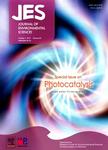Achieving nitritation at low temperatures using free ammonia inhibition on Nitrobacter and real-time control in an SBR treating landfill leachate
Achieving nitritation at low temperatures using free ammonia inhibition on Nitrobacter and real-time control in an SBR treating landfill leachate作者机构:Key Laboratory of Beijing Water Quality Science and Water Environment Recovery Engineering Beijing University of Technology School of Environmental and Municipal Engineering Lanzhou Jiaotong University
出 版 物:《Journal of Environmental Sciences》 (环境科学学报(英文版))
年 卷 期:2015年第27卷第4期
页 面:157-163页
核心收录:
学科分类:083002[工学-环境工程] 0830[工学-环境科学与工程(可授工学、理学、农学学位)] 08[工学]
基 金:supported by the National Natural Science Foundation of China (Nos. 51168028, 51168027) the Science and Technique Foundation Project for Youth of Gansu Province (No. 1107RJYA279)
主 题:Landfill leachate Nitritation Low temperature Free ammonia Inhibition AOB and NOB
摘 要:Free ammonia(FA) inhibition on nitrite-oxidized bacteria(NOB) and real-time control are used to achieve nitrogen removal from landfill leachate via nitrite pathway at low temperatures in sequencing batch reactor. The inhibition of FA on NOB activity during the aerobic period was prolonged using real-time control. The degree of nitrite accumulation was monitored along with variations of the ammonia-oxidizing bacteria and NOB population using fluorescence in situ hybridization techniques. It is demonstrated that the end-point of ammonia oxidization is detected from the on-line measured dissolved oxygen,oxidization–reduction potential, and p H signals, which could avoid the loss the FA inhibition on NOB caused by excess aeration. At low temperature(13.0–17.6°C), the level of nitrite pathway rapidly increased from 19.8% to 90%, suggesting that nitritation was successfully started up at low temperature by applying syntrophic association of the FA inhibition and real-time control, and then this high level of nitrite pathway was stably maintained for as long as 233 days. Mechanism analysis shows that the establishment of nitritation was primarily the result of predominant ammonia-oxidizing bacteria developed in the nitrifying bacteria population compared to NOB. This was mainly due to a gradual reduction of nitrite amount that is available to provide energy for the growth of NOB,eventually leading to the elimination of NOB from the bacterial clusters in sequencing batch reactor sludge system.



